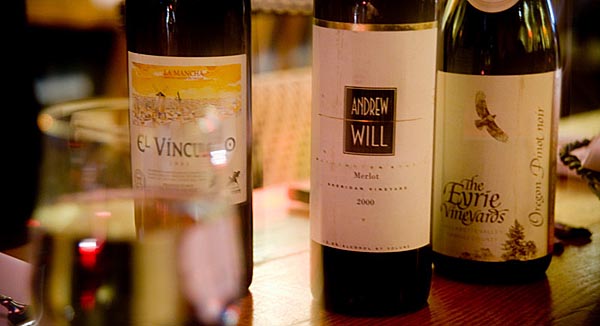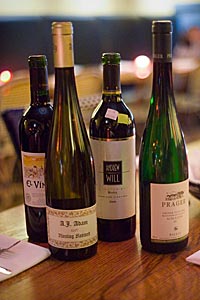
As a food writer, Dara Moskowitz Grumdahl is well known, even beloved, for her ability to tell stories about food in a voice that is as distinctly hers as it is delightful to read, providing local foodies with insight and a full portion of wit. In Drink This: Wine Made Simple, her first book, the James Beard Award-winning food and wine columnist and Minnesota Monthly editor is all that in long form. The book is an entertaining read and a first-rate plunge into, as she says, “the most wonderful drink in the world.”
Of course, wine is not simple. In fact, it’s so dadblasted confounding and complex that for many of us, approaching even the most pared down restaurant wine list is mildly intimidating — is it the good stuff or is it an inappropriate, over-priced wine, a wine in such poor taste that it reveals my despicable lack of knowledge for all to see? In Drink This (384 pages, $26.00), Grumdahl tells would-be wine aficionados that the only taste that matters is their own:
The same rules hold true for wine as for the rest of human taste: some people like chocolate cake, and some people like apple pie … The only difference is that when it comes to wine there are people at the top saying: My favorite chocolate cake, 98 points … Most people think critical scores are objective things … they’re really just some guy’s opinion, and just because some guy tells you that he likes some particular chocolate cake, or Cabernet Sauvignon, is no reason to alter your behavior … The reason you want what you want is because of your taste. The real problem with new wine drinkers is simply that they don’t know what their taste is, because they haven’t tasted all the representative wine styles.
The only way to know your own mind about wine is to drink a lot of it. Not in a drunken, messy kind of way, but in a methodical, organized kind of way. Drink This is structured around nine major wine varietals: Zinfandel, Sauvignon Blanc, Riesling, Chardonnay, Cabernet Sauvignon, Syrah, Sangiovese, Tempranillo, and Pinot Noir. In her approach, Grumdahl is as orderly as a primer, taking readers through an easily digestible overview including what’s to love (great $10 wines) and hate (officious wine labels!) about the wine; a brief history of the grape and its terroir and winemaking; and then a tasting, alone or with friends. Interspersed throughout these lesson plans are brief interviews with industry winemakers, chefs, sommeliers, and critics, who discuss everything from stemware to the role of an importer to terroir — the latter in a rather ponderous conversation with Bonny Doon founder Randall Graham, in which he seems on the verge of giving it all up — delicious tidbits that only make the book more insightful and enjoyable.

In fact, the book is so very readable, so jam-packed with Grumdahl — “Put a Zinfandel next to sole in a butter sauce and you will experience something in your mouth akin to King Kong stepping on the Easter Bunny” — it’s tempting to plow right through it, gobbling up fresh perspective and wine knowledge as you go, but plan to take it again, chapter by chapter.
And here’s why: The best of the book, the key to understanding wine, is in its highly prescriptive step-by-step tastings. “The reason that wine is hard to learn about is that you can read about it for six straight years and that experience will be but dust in the wind compared to tasting it,” Grumdahl writes. “In wine, tasting is everything. It’s the most important part of wine, end of story.”

To increase the reader’s success in this endeavor, the author provides a guide not only to price and vineyard, but also to shopping. In the Syrah chapter, she suggests buying five bottles: A bottom shelf Australian Shiraz, a single-vineyard American Syrah, a Washington State Syrah, a real French Syrah, and a single-vineyard Barossa Valley Shiraz. That gives the reader categories to take to their local wineseller, rather than trying to hunt around for an exact bottle or cobble together a random assortment of wines that won’t provide the same comprehensive view of the varietal. The author also includes pairing suggestions and tasting markers — the better to help tasters pick out elusive fragrances like raspberry, fresh grass, chocolate, coffee, and tobacco.
Drink This is a handbook, but it’s also a veritable kickstand, propping up the intimidated. Throughout the book, but especially at the end in her “Wine Drinkers Bill of Rights,” Grumdahl advocates for the reader’s enjoyment of wine. This is as much about feeling comfortable with a limited knowledge of wine as it is about learning what you like and drinking it when you feel like it. For Grumdahl and the people she interviews, it all comes down to hospitality. Here she talks to John Ragan, the sommelier for Eleven Madison Park restaurant in New York City:
Think of a wine list as a haystack, and the perfect wine you seek as the needle in it. “It’s the sommelier’s job to dig through this haystack, not yours,” Ragan says. “All someone really needs to know is how much they want to spend, and what sort of experience they want to have — something red, something funky and earthy, or what have you. The only concerns a great sommelier should have are making friends, helping you have a good time, and creating an experience so good that people want to come back.”
That’s a nice perspective change: Good wine sellers and sommeliers are not there to make you feel silly, even if you FOO-may rather than fyu-MAY your fumé. Like the wine, they are there to enhance your experience. As Grumdahl writes: “The point of learning about wine is not to know everything about wine. The point of learning about wine is to enjoy life more.”

Susan- thanks for this. Your comment about sommeliers not being there to make you feel silly, even if you ‘foo-may’ etc. ‘Foo-may is the more correct French pronunciation, as opposed to ‘few-may’ , do we agree?
Artsy,
According to Ms. Grumdahl, it is in fact fyu-MAY. Here is a nice recording of the word:http://forvo.com/word/pouilly-fume/, for your listening and dancing pleasure.
Susan
I’m half-way through this book and I’ve found it to be a revelation about wine, much for the reasons cited in this review. As someone who regularly drinks wine, talks to wine store guys, and has attended a fair share of wine tastings, I still admit I know little about the drink.
The reason I know little is because I’ve never approached it systematically, and there are simply millions of bottles to try. The revelation to me of the book is simply this: buy five bottles of the same type of wine at different price points, and seek to understand a specific varital, one at a time.